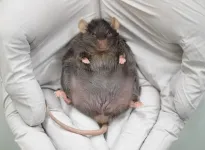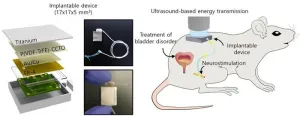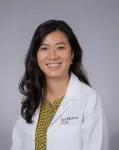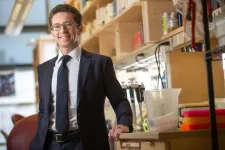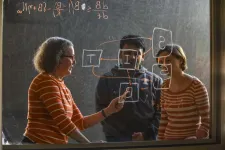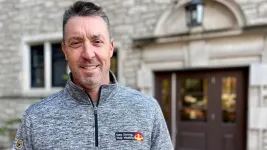(Press-News.org) CORVALLIS, Ore. – Oregon State University researchers have discovered vitamin B1 produced by microbes in rivers, findings that may offer hope for vitamin-deficient salmon populations.
Findings were published in Applied and Environmental Microbiology.
The authors say the study in California’s Central Valley represents a novel piece of an important physiological puzzle involving Chinook salmon, a keystone species that holds significant cultural, ecological and economic importance in the Pacific Northwest and Alaska.
Christopher Suffridge, senior research associate in the Department of Microbiology in the OSU College of Science, and doctoral student Kelly Shannon examined concentrations of thiamine and the microbial communities in rivers of the Sacramento River watershed. Thiamine is the compound commonly referred to as vitamin B1 and is critical to cellular function in all living organisms.
“This study is the first-ever report of thiamine compounds in salmon spawning rivers and the associated gravels where salmon spawn,” Suffridge said. “This source of thiamine has potential implications for reducing health impacts on naturally spawning salmon that are suffering from thiamine deficiency complex.”
TDC, an emerging threat to the stability of West Coast salmon populations, has affected salmon and trout in lake systems in northeastern North America and Atlantic salmon in the Baltic Sea.
Chinook salmon in the Central Valley have recently been diagnosed with TDC, the researchers note. Afflicted female salmon that return to rivers and streams to spawn can pass the deficiency on to their hatchlings, which have problems swimming and experience high mortality rates.
“In California, most hatchery-spawning Chinook salmon are treated with thiamine to prevent TDC,” Suffridge said. “However, it was previously unknown if there was a source of thiamine in the environment that could potentially rescue naturally spawning salmon afflicted with TDC. We have now identified microbially produced thiamine in natural salmon spawning habitats.”
“It's a complicated issue,” Shannon added. “The broader context is that Central Valley Chinook salmon, as well as some populations of salmon in other places, are becoming thiamine deficient because of shifts in their diet in their feeding grounds.”
Historically, Shannon said, Central Valley Chinook salmon ate a diverse, healthy diet consisting of many different species of prey fish. But in recent years, shifts in the ocean ecosystem have caused northern anchovy populations to explode, meaning they’ve become the primary dietary component for salmon. This change in diet is the likely cause of TDC, he said.
“Northern anchovies are high in an enzyme called thiaminase that degrades thiamine,” Shannon said. “So by the time many California Central Valley Chinook salmon are ready to spawn they have been feeding on so many anchovies that they have become deficient in thiamine from the activity of the thiaminase enzyme in anchovies.”
The results of the new study implicate river sediments as likely sources of microbial thiamine, which could supplement early life stages of Chinook salmon that experience TDC, he said. Future studies will examine to what degree environmental thiamine acquisition by adult Chinook salmon, their incubating eggs and hatched fry could alleviate the negative health outcomes caused by TDC.
“It was unknown if the vitamin could even be measured in rivers in the first place, and the thiamine concentrations we measured were much lower – more than a million times lower – than a hatchery thiamine bath,” Shannon added. “The data have implications for salmon health but are not concrete enough to say anything definitive. More research is needed to determine what role the environmental thiamine might play, but obviously learning that it’s there is an important first step.”
The collaboration included Rick Colwell, a professor in the OSU College of Earth, Ocean, and Atmospheric Sciences, and Hailey Matthews, who graduated from the Oregon State Honors College in June 2023.
Also taking part in the study were scientists from the National Oceanic and Atmospheric Administration, the University of California, Davis, Bronx Community College and the California Department of Water Resources.
The California Department of Fish and Wildlife was the primary funder of this research. Additional support was provided by the National Science Foundation.
END
Vitamin discovered in rivers may offer hope for salmon suffering from thiamine deficiency disease
2024-01-04
ELSE PRESS RELEASES FROM THIS DATE:
An electrophysiological breakthrough for diabetic brain studies
2024-01-04
Overview
A research team from the Institute for Research on Next-generation Semiconductor and Sensing Science (IRES²) at the Toyohashi University of Technology, National Institute of Technology, Ibaraki College, and TechnoPro R&D Company has successfully demonstrated low-invasive neural recording technology for the brain tissue of diabetic mice. This was achieved using a small needle-electrode with a diameter of 4 µm. Recording neuronal activity within the diabetic brain tissue is particularly challenging due to various complications, including the development of cerebrovascular disease. Because of the significant advantage of the miniaturized needle-electrode compared to conventional ...
Using static electricity to enhance biomedical implant durability
2024-01-04
Medical technology innovations achieved by integrating science and medicine have improved the quality of life for patients. Especially noteworthy is the emergence of electronic devices implanted in the body, such as in the heart or brain, which enable real-time measurement and regulation of physiological signals, presenting new solutions for challenging conditions like Parkinson's disease. However, technical constraints have hindered the semi-permanent use of electronic devices after their implantation.
A collaborative research team led by Professor Sung-Min Park from the Departments of Convergence IT Engineering, Mechanical Engineering, and ...
Hearing aids may help people live longer
2024-01-04
LOS ANGELES — Hearing loss affects approximately 40 million American adults, yet only one in 10 people who need hearing aids use them, research shows.
Those who don’t use hearing aids but should may want to make wearing them one of their New Year’s resolutions, according to a new study from Keck Medicine of USC published today in The Lancet Healthy Longevity.
“We found that adults with hearing loss who regularly used hearing aids had a 24% lower risk of mortality than those who never wore them,” ...
Surgical teams put on notice for poor behaviour
2024-01-04
Australian researchers have successfully trialled a novel experiment to address offensive and rude comments in operating theatres by placing ‘eye’ signage in surgical rooms.
The eye images, attached to the walls of an Adelaide orthopaedic hospital’s operating theatre without any explanation, had the desired effect in markedly reducing poor behaviour among surgical teams.
Lead researcher University of South Australia Professor Cheri Ostroff attributed the result to a perception of being “watched”, even though the eyes were not real.
The three-month experiment ...
The Avocado Debate: a polarizing fruit and its impact on society
2024-01-04
The avocado has soared to unprecedented heights of popularity, gracing the plates of toast enthusiasts and health-conscious individuals worldwide. But what are the overlooked consequences of our latest food obsession?
“The avocado has come to represent so much more than just a fruit. It’s wrapped up with ideas of generational conflict, environmental chaos and social injustice. Over the last century, through careful marketing, it has evolved into a commodity crop with a huge social media following.” says Honor May Eldridge, a food policy expert who works to promote sustainable agriculture around the ...
Jonathan Stamler, MD, named fellow of the 2023 National Academy of Inventors
2024-01-03
CLEVELAND, Ohio – Jonathan Stamler, MD, has been named a Fellow of the National Academy of Inventors (NAI). Dr. Stamler is the co-founder and president of Harrington Discovery Institute at University Hospitals (UH), and the Robert S. and Sylvia K. Reitman Family Foundation Distinguished Professor of Cardiovascular Innovation at the Case Western Reserve University School of Medicine.
Election as an Academy Fellow is the highest professional distinction awarded solely to inventors and the 2023 Class of Fellows ...
UT’s Lenhart honored to deliver the American Mathematical Society’s Gibbs Lecture at Joint Mathematics Meeting
2024-01-03
Suzanne Lenhart, Chancellor’s Professor in the Department of Mathematics, will join a storied list of honored speakers to deliver the Josiah Willard Gibbs Lecture at the world’s largest annual math gathering, the American Mathematics Society (AMS) Joint Mathematics Meetings (JMM2024), taking place January 3–6, 2024, in San Francisco.
JMM2024 brings researchers from 20 national and international partner associations to share the latest developments in mathematical thought and application.
Lenhart is the ...
An enhanced brain delivery of antibodies heightens the potential to treat brain diseases
2024-01-03
BIRMINGHAM, Ala. – The blood-brain barrier blocks the entry of antibodies into the brain. This limits the potential use of antibody therapeutics to treat brain diseases, such as brain tumors.
Elsewhere in the body, more than 100 United States Food and Drug Administration-approved therapeutic antibodies are used by medical teams to treat cancers and autoimmune, infectious and metabolic diseases. Finding ways to transport therapeutic antibodies across the blood-brain barrier — from the peripheral blood stream into the central nervous system — could create effective treatments that act in the brain.
In a study published in the journal Frontiers in Cell and Developmental ...
US Department of Energy issues request for proposals for contractor to manage and operate Fermi National Accelerator Laboratory
2024-01-03
Today, the U.S. Department of Energy (DOE) announced the issuance of a Request for Proposals (RFPs) for the competitive selection of a management and operating contractor for Fermi National Accelerator Laboratory (FNAL).
FNAL is a single-purpose laboratory that leads the nation in the construction and operation of world-leading accelerator and detector facilities and in the development of the underlying technology for particle physics research. Its mission is centered on delivering breakthrough science and technology ...
Fitness with no age limit
2024-01-03
For nearly 20 years, Stephen Ball has been a man on a mission: helping older Missourians stay healthy and get stronger through physical activity.
In 2005, the professor in the University of Missouri College of Health Sciences helped created a program called Stay Strong Stay Healthy (SSSH). Since then, the eight-week strength training program has helped more than 20,000 older adults across five states. Participants aged 60 and up are taught how to safely complete exercises — including squats, bicep curls and lunges — in a comfortable, friendly environment.
“One thing I always ...
